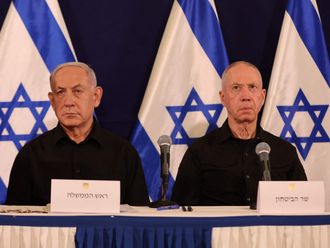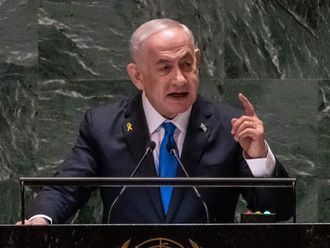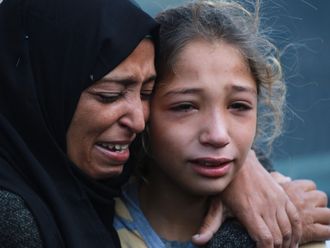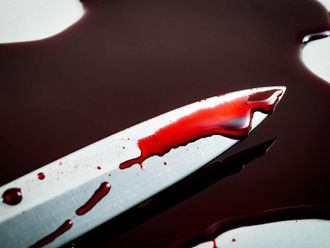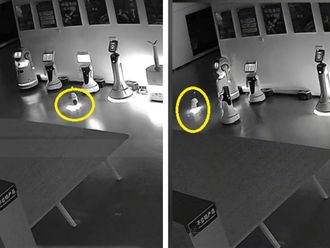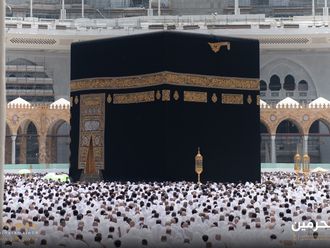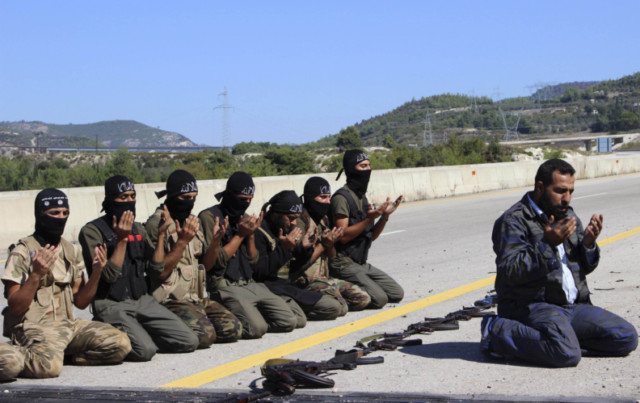
Gaziantep: Shortly before its operatives killed 14 Iraqi Shiite children in a school bombing this month, the group once known as Al Qaida in Iraq sent guerrillas into northern Syrian villages with orders to reopen local Sunni classrooms. In a series of early fall visits, the militants handed out religious textbooks along with backpacks bearing the group’s new name: the Islamic State of Iraq and Syria.
A four-hour drive to the east, a rival Al Qaida faction called Jabhat Al Nusra was busy setting up a jobs programme in Al Shaddadi, a desert town it has held since February. The Islamists restarted production in an oil field that had been idled by fighting, and fired up the town’s natural gas plant, now a source of income for the town and its new rulers.
The two rebel groups, with their distinct lineages to the terrorist network founded by Osama Bin Laden, have concentrated Western fears of rising jihadist influences within Syria’s rebel movement. Two and a half years after the start of the country’s uprising, Islamists are carving out fiefdoms and showing signs of digging in.
“We all have the same aqidah [Islamic creed] as Al Nusra or the Islamic State,” said a 23-year-old Jordanian Palestinian who gave the name Abu Abdullah in an interview in Jordan and who fights for a rebel brigade allied with the Islamists. “The aim is to free the Muslim lands and have the Islamic flag there.”
The prominence of the two groups — as fighters, as recruiters and, more recently, as local administrators — appears to have accelerated even as the Obama administration seeks to bolster moderate and secularist rebels with new weapons and training. Multiple independent studies as well as Western and Middle Eastern intelligence officials show the hard-line Islamists surging ahead by almost every measure, undermining Western efforts to find a democratic alternative to Syrian President Bashar Al Assad.
The Al Qaida affiliates have clashed with other rebel groups, and occasionally with each other, and their heavy use of foreign fighters and attempts to impose an ultra-conservative ideology have alienated some Syrians accustomed to secular rule.
“The situation is so bad,” said Mohammad Abdul Aziz, an activist in the city of Raqqa who says the Islamic State of Iraq and Syria — popularly known as Isis — criminalised the use of tobacco and carried out public executions. “A lot of people have just escaped the city, and many more are planning to.”
But other Syrians have embraced the jihadists and welcomed the return of civil order in towns devastated by months of fighting.
A 22-year-old Syrian fighter who called himself Abu Bahri said in an interview here that about 100 people from his home town of Azaz joined Isis after becoming frustrated with the inefficiency of the more moderate Northern Storm brigade, which was in charge of the town. And the failure of the West to end the bloodshed has strengthened the message of extremists. “I support them because they hate the US, they hate the West, which has cheated us,” said Mohammad Saeed, a humanitarian aid worker from Palmyra now based in the Turkish border town of Reyhanli.
“In Syria, [the Islamists] have a level of control they never enjoyed in Iraq,” said Aymenn Al Tamimi, an expert on Syrian jihadist groups at the Middle East Forum, a Washington nonprofit research organisation. In addition to their fighting and organising skills, he said, they appear to have absorbed lessons from Iraq, where Al Qaida’s indiscriminate attacks against civilians horrified and repulsed ordinary Iraqis and all but destroyed the terrorists’ support network.
“They’ve learned that you do need some outreach to locals; you can’t just entirely exploit them,” Tamimi said. A key part of that strategy, he added, is “outreach to children”.
In the competition for local sympathies, the advantage so far belongs to Jabhat Al Nusra, an offshoot of Al Qaida in Iraq that has publicly aligned itself with Ayman Al Zawahiri, Bin Laden’s longtime deputy and his successor as the leader of Al Qaida. Since its founding early last year as a Syrian rebel group, Jabhat Al Nusra has played down its connections to the international terrorist movement while seeking to limit collateral damage from the suicide attacks and roadside bombings that are its preferred weapons against Syrian government forces.
A much harder challenge confronts Isis — the rebranded terrorist group behind a campaign of savage attacks on Shiite markets, schools and villages in neighbouring Iraq. The group’s 8,000-strong Syrian contingent boasts a larger proportion of foreign jihadists than any other rebel group, according to analysts. In just six months of operations in the country, it has managed to frighten and enrage Syrians with its extreme interpretation of Islam — including beatings and executions for perceived religious infractions.
Yet in recent weeks Isis, too, has sought to reform its image by reopening schools and delivering food, medicine and energy to war-weary towns and villages. It has sponsored ice-cream eating contests and tug-of-war competitions for children and built training camps where teens learn fighting skills and participate in singalongs calling for the destruction of Al Assad and his allies, the “lowlifes and infidels.”
Some Syrians who disapprove of Isis’s religious zeal said they applauded the arrival of the disciplined, battle-hardened force if it could shift the momentum in a fight that has appeared deadlocked for months.
“If the Islamic State were organised and didn’t interfere in people’s lives, we would welcome them,” said Mahmoud Al Hassan, a 30-year-old trader from Aleppo, who was visiting a hospital in neighbouring Turkey after his cousin was shot by a sniper.
To Western governments, however, the jihadists’ entrenched position in Syria is another ominous turn in the conflict. US and Middle Eastern officials say the two are a magnet for much of the foreign cash as well as the majority of the foreign fighters streaming into Syria.
But what troubles Western observers is not the groups’ fighting prowess, but their shared vision of a jihad that extends beyond Assad’s ouster. While other rebels fight to remove the Syrian dictator, former and current US and Middle Eastern officials say, the Al Qaida groups are transforming the conflict into a symbolic struggle against the West and Israel, using words and images that resonate with like-minded Muslims, from the Arab Peninsula to Western Europe.
Abu Khaled, a 26-year-old Lebanon-born fighter, said the battlefield in Syria has expanded because of groups such as Isis, inspiring hope that Arab Spring uprisings across the Middle East will give rise to a broader Islamic revolution in which all secular and Western-backed leaders will be replaced.
“We always said one of the main problems are the rulers, and now, see how one after the other is disappearing,” said Khaled, who spoke on the condition that his full name not be revealed. “And it won’t stop until we get our aim.”
The formal titles adopted by both Al Qaida groups include the Arabic term for greater Syria — Al Sham — that radical Islamists use to link their movement to the ancient Islamic caliphate that ruled a vast swath of the Middle East, with Damascus as its capital. Its use, the jihadists say, evokes an image of a future Middle East in which present-day boundaries and governments have been replaced by a single Islamic state, encompassing the territories of Syria, Lebanon, Iraq, Jordan and Israel.
It is the groups’ appeal to a greater jihad that explains why foreign volunteers continue streaming into Syria in numbers that surpass those seen during earlier conflicts in Afghanistan, Bosnia or Iraq, said Bruce Riedel, a former CIA officer and adviser on the Middle East to four US administrations.
“Syria has become the most important destination for aspiring jihadists ever, because it is the heart of the Muslim world on the border of Palestine,” said Riedel, now a senior fellow at the Brookings Institution. “For jihadis, it is the road to Jerusalem at last.”
To terrorism experts, it was inevitable that an Al Qaida-aligned terrorist group would arise from the brutal sectarian violence of Syria’s civil war. How the conflict came to have two competing Al Qaida factions is a story that reflects the power struggles within the jihadist movement in the decade after the September 11, 2001, terrorist attacks.
Both Syrian groups trace their roots to the organisation once commonly known as Al Qaida in Iraq, the terrorist faction that was founded by the Jordanian Abu Musab Al Zarqawi and notorious for a string of beheadings and spectacular bombings during the US occupation of Iraq. After Zarqawi’s death in 2006, the organisation was nearly destroyed through a combination of US military pressure and a near-universal rejection of its tactics by Iraqi Sunni Muslims.
The group changed its name after Zarqawi’s death, becoming the “Islamic State of Iraq,” but it never fully recovered. Only a handful of cells remained active in Iraq when the start of the Syrian uprising offered a chance for the group to reassert itself, on a different stage.
The Islamic State sent a stream of operatives into Syria in the early months of the uprising, and then, in early 2012, it backed the formation of new rebel group, Jabhat Al Nusra li-Ahl Al Sham, or the Support Front for People of Greater Syria. Its leader, Abu Mohammad Al Golani, had been a senior member of the Iraqi terrorist organisation, and he acknowledged receiving start-up money from his comrades in Baghdad.
Citing the group’s ties to Al Qaida, the State Department officially labelled the Jabhat Al Nusra a terrorist organisation in December. But in public statements, Golani played down Jabhat Al Nusra’s Iraqi origins and insisted that his group’s sole focus was defeating the Assad government.
Still, Jabhat Al Nusra quickly distinguished itself from other rebel groups through its reliance on foreign fighters as well as military tactics and weapons perfected during the Iraq conflict: suicide bombers and improvised explosive devices, or IEDs.
Meanwhile, tensions were quietly building between Jabhat Al Nusra and its parent organisation, and early this year they spilled into the open. On April 9, the Iraq group announced yet another name change — this time to the Islamic State of Iraq and Syria — and claimed Jabhat Al Nusra as the organisation’s Syrian branch. A day later, Golani fired back with a statement denying any connection with the Iraqis and swearing allegiance to Zawahiri, the leader of Al Qaida’s global network.
“Syria is such a mess that even Al Qaida is split,” said Kadar Sheikhmous, a Syrian activist based in this southern Turkish city.
Zawahiri himself was called upon to mediate the dispute. The gray-bearded Egyptian issued a statement in June declaring that the two were independent branches of Al Qaida. Then he called on both to cooperate.
“Stop any verbal or physical attack against the other side,” Zawahiri wrote in an open letter to the two groups.
Ideological spats continue on social media websites such as Twitter and Facebook, and the two groups compete for resources.
Yet despite the leadership rift and differences over tactics, the two jihadist factions now cooperate more often than they clash, according to US and Middle Eastern experts who have studied both groups. In some contested cites, such as Aleppo, the two groups fight as separate entities, sometimes coordinating tactics. In other areas, such as rebel-held Raqqa city in north-central Syria, they have been virtually interchangeable, with allegiances constantly shifting, experts say.
“They operate in parallel to one another,” said Aaron Zelin, an expert on jihadist groups with the Washington Institute for Near East Policy. “They have different command structures, and Isis uses more foreign fighters — about 30 to 40 percent of its forces, versus Al Nusra’s 10 per cent. But you can’t say that one is that different from the other. They swim in the same ideological waters.”


